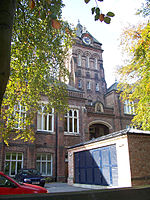Darlington Football Club is an association football club based in Darlington, County Durham, England. As of the 2023–24 season, the team competes in the National League North, at the sixth level of English football.
The club was founded in 1883, and played its matches at Feethams. The club originally played in regionally organised leagues, and was one of the founding members of the Northern League in 1889. They were first admitted to the Football League when the Third Division North was formed in 1921. They won the Third Division North title in 1925, and their 15th place in the Second Division in 1926 remains their highest ever league finish. After their admission to the League, they spent most of their history in the bottom tier. They won the Third Division North Cup in 1934, their first victory in nationally organised cup competition. They reached the last 16 of the FA Cup twice, and the quarter-final of the League Cup once, in 1968. In the early 1990s they won successive titles, in the Conference National in 1990 and the Fourth Division in 1991. In 2011 they won the FA Trophy, defeating Mansfield Town 1–0 at Wembley Stadium.
Darlington moved to the all-seater, 25,000-capacity Darlington Arena in 2003. The cost of the stadium was a major factor in driving the club into administration in 2003, 2009, and 2012. As the fan owned club was unable to agree a creditors voluntary agreement it was expelled from the Football Association (FA). A new club was immediately formed and moved to Blackwell Meadows stadium but the FA ruled that, as a new club, it must have a different playing name from the expelled club. The name chosen was Darlington 1883, and that club was placed in the Northern League Division One, the ninth tier of English football, for the 2012–13 season. They won three promotions in four seasons before the FA approved their request to change to the traditional Darlington FC name.
The club have at times worn strips of black and white shirts, black shorts and black and white socks. The club's crest depicts Locomotion No. 1, referring to the town's railway history; as well as a stylised Quaker hat, referring to the religious movement that had a historic influence on the town, and which was the source of the team's nickname, the Quakers. The club's main rival's historically are Hartlepool United.






